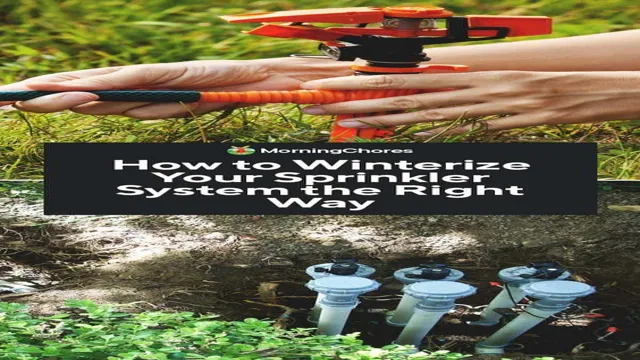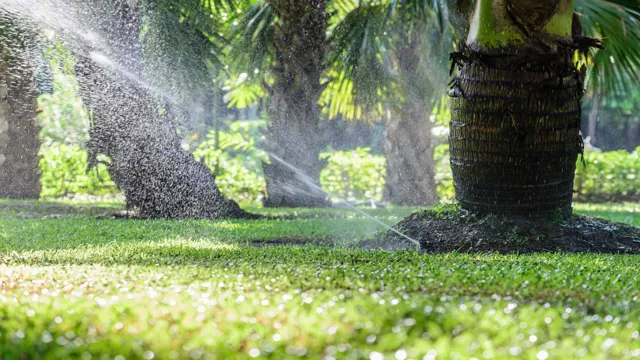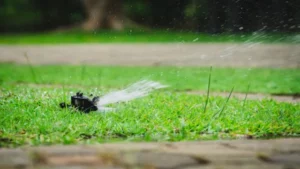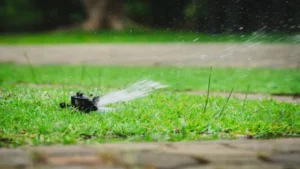Winter is here, and while the thought of snow-covered landscapes may look picturesque, it is essential to check if our lawn sprinkler systems are taken care of. With the temperatures dropping, the fear of the water system freezing haunts homeowners, leading to expensive repair costs. Preventing Lawn Sprinkler System Freezing should be at the top of your to-do list this winter.
Not taking care of your lawn’s irrigation system before the cold sets in can lead to severe damage and a hefty bill. However, there are ways to prevent this from happening and ensure that your lawn stays healthy and thriving come spring. Let’s dive in and explore how you can prepare your sprinkler system for the winter months ahead.
Understanding Lawn Sprinkler System Freeze Points
Freezing temperatures can spell trouble for lawn sprinkler systems, causing pipes and fittings to burst and leading to expensive repairs. Understanding the freeze points of your system is essential for preventing this from happening. The freeze point is the temperature at which the water in your system starts to freeze, which can cause pressure to build up and lead to cracks or breaks.
To keep your sprinkler system from freezing, you need to make sure that all components are drained and turned off before the first frost hits. It’s also a good idea to insulate any above-ground pipes and backflow preventers to keep them from freezing. If you live in an area with particularly harsh winters, you may need to consider installing a freeze sensor that will shut off the water supply if the temperature drops too low.
By taking these precautions, you can help ensure that your lawn sprinkler system will be in good working order and ready to use when spring arrives.
Identifying Freeze Points in the System
As winter approaches, it is important for homeowners to understand the freeze points in their lawn sprinkler system. Freeze points are areas in the system where water can become trapped and freeze, causing damage to the pipes and sprinkler heads. Common freeze points include above-ground pipes, backflow preventers, and valves.
To prevent damage, it is important to properly winterize the system by draining all water from the pipes, shutting off the water supply, and insulating any above-ground pipes. Neglecting to winterize the system can lead to burst pipes, costly repairs, and a non-functioning sprinkler system come springtime. So take the time to identify the freeze points in your system and properly winterize it to ensure a fully functional system next season.

Understanding the Ideal Temperatures for Lawn Irrigation Systems
When it comes to lawn irrigation systems, it’s essential to understand the ideal temperatures for their operation. One of the most critical factors to consider is the sprinkler system freeze points. When temperatures drop below freezing, water in the pipes can freeze, causing the pipes to burst and potentially damaging your lawn.
It’s crucial to know the freeze point of your sprinkler system and to make sure you turn off the system before temperatures drop below this point. If you’re unsure of the freeze point, consult with a professional. Generally, sprinkler systems should be turned off when the temperature drops below 32 degrees Fahrenheit.
Protect your lawn and prevent costly repairs by understanding and monitoring your sprinkler system’s freeze point.
Insulate the Lawn Sprinkler System
Winter is coming and it’s crucial to keep your lawn sprinkler system from freezing. One effective way to do that is to insulate your system. This can be done by adding insulation to the pipes, valves and backflow device.
You can use foam insulation sleeves or heat tape. However, it’s important to properly install these materials to avoid leaving any gaps. Additionally, make sure to remove any excess water from the system before insulating.
Insulating your lawn sprinkler system can save you from costly repairs and replacements that can occur if the pipes freeze and burst. Don’t let the freezing temperatures damage your lawn sprinkler system, take the necessary precautions and insulate it today.
Adding Insulation to the System
Insulating your lawn sprinkler system is an important step in protecting it from freezing temperatures and preventing potential damage. Adding insulation to the system can help keep the water in the pipes warm, preventing it from expanding and causing pipes to burst. One way to insulate your sprinkler system is by using foam insulation sleeves, which can be easily installed over the pipes.
These sleeves come in various sizes and are designed to fit snugly around the pipes, providing insulation and protection from the cold. Another option is to use heat tape, which is a specialized electrical tape that helps to keep the pipes warm. This tape can be wrapped around the pipes and plugged into an electrical outlet, providing a constant source of heat.
By taking the time to properly insulate your lawn sprinkler system, you can help ensure that it remains in good condition year-round, reducing the need for costly repairs and replacements. So, why not take the proactive step of adding insulation to your system today?
Use Insulated Tape to Protect against Freezing
One of the things that we tend to overlook as homeowners is the maintenance of our lawn sprinkler system. Rather than waiting until the first freeze to make sure everything is working efficiently, it’s better to take preventative measures before the winter arrives. One way to achieve this is by insulating your sprinkler system.
Using insulated tape is a simple method of protecting your pipes from bursting in freezing temperatures. The tape helps to regulate the temperature, preventing the water from freezing and expanding inside the pipes. This is especially relevant if you live in areas that experience extreme winters.
Insulating your sprinkler system is an investment that pays off in the long run, saving you time and money from any costly repairs. It is important to remember that taking care of your lawn sprinkler system is essential to ensure it lasts for years to come.
Cover Exposed Pipes to Insulate
If you want to ensure your lawn sprinkler system remains efficient and effective, it’s important to insulate it properly. One key way to do this is to cover exposed pipes. When pipes are left exposed, they can easily become damaged due to changes in temperature, which can lead to a costly repair bill down the line.
By covering your pipes with insulated sleeves or wraps, you’ll provide an extra layer of protection against the elements. This insulation will help to regulate the temperature of the water that flows through your system, preventing it from freezing during the colder months. Not only will this save you money in the long run, but it will also ensure that your lawn receives the right amount of water at the right time.
With a well-insulated sprinkler system, you’ll be able to enjoy a lush, healthy lawn year-round, without having to worry about costly repairs or wasted water. In conclusion, insulating your lawn sprinkler system is an easy and cost-effective way to protect your investment and ensure that your lawn remains in great shape. By covering exposed pipes with insulated sleeves or wraps, you’ll be able to enjoy all the benefits of a well-maintained sprinkler system without any of the hassle.
So why wait? Insulate your sprinkler system today, and reap the rewards for years to come!
Drain Your Lawn Sprinkler System
One important step in protecting your lawn sprinkler system during the colder months is to drain it properly. This is especially crucial if you live in an area with freezing temperatures. When water is left in the system, it can freeze and cause serious damage.
That’s why it’s essential to turn off the water supply and use either a manual or automatic drain valve to remove all the water from the pipes. It’s also important to properly store sprinkler heads and other components to prevent damage. By taking the time to drain your lawn sprinkler system, you can avoid costly repairs and ensure that your system works properly when you need it most.
Using Compressed Air to Clear Out the System
Draining your lawn sprinkler system before winter can help prevent costly damage from frozen pipes. One effective method is using compressed air to blow out any remaining water in the pipes. This can be done with the help of a professional or by using a DIY air compressor kit.
Start by shutting off the water supply and opening all the valves to let the water drain out. Then, connect the air compressor to the system and gradually increase the pressure until all the water has been forced out. Remember to do this carefully, as excessive pressure can cause damage to the pipes.
By taking the necessary precautions, you can avoid costly repairs and keep your sprinkler system running smoothly for years to come. So, don’t let the winter season catch you off guard, ensure your sprinkler system is winterized and protected.
Removing Remaining Water By Hand
As the colder months approach, it’s important to drain your lawn sprinkler system to prevent any damage from freezing temperatures. One key step in this process is removing any remaining water by hand. This can be done using a variety of methods, such as blowing compressed air through the system or using a manual drain valve.
It’s crucial to ensure all water is removed to prevent any water from freezing and causing damage to pipes or other components. While it may seem like a tedious task, taking the time to properly drain your sprinkler system can save you from costly repairs in the long run. So grab some gloves and get to work – your lawn will thank you come springtime!
Monitor Your Lawn Sprinkler System Regularly
If you want to keep your lawn sprinkler system from freezing, it’s crucial to monitor it regularly. Check all the components – the valves, pipes, and sprinkler heads – to ensure the system is working correctly. Pay attention to any signs of wear and tear or leaks, which can lead to water pooling and, ultimately, freezing.
It’s also important to keep the system drained when the temperature drops below freezing. By doing so, you can prevent water from expanding and cracking the pipes. Additionally, consider adding insulation to vulnerable parts of the system, such as the backflow preventer and valve boxes.
This will help protect these areas from freezing and damage. By taking these preventive measures and monitoring your lawn sprinkler system regularly, you can prevent freezing and maintain your yard’s healthy green appearance throughout the year.
Identifying Leaks or Malfunctions in the System
Regular Maintenance for Lawn Sprinkler Systems Regular maintenance is a crucial part of keeping your lawn sprinkler system operating at its best. By doing so, you can prevent leaks or malfunctions and save money on costly repairs down the line. One way to monitor your system is by observing how efficiently it waters your lawn.
If dry spots or overwatered areas appear, there could be a problem with the system’s coverage or alignment. You can also inspect each sprinkler head and nozzle for damage or dirt that could affect their performance. Checking the irrigation timer to ensure it is set correctly is important as well.
Additionally, inspecting valves and fittings for wear and tear can help prevent leaks and other issues. By regularly monitoring your lawn sprinkler system, you can detect problems early and make repairs quickly to prevent any further damage.
Conclusion
In the battle against frosty pipes, preventative maintenance is the key. By taking a few simple precautions, such as blowing out your system and insulating your pipes, you can keep your lawn sprinkler system from freezing. So, be a savvy homeowner and don’t let Jack Frost ruin your sprinkler system’s day!”
FAQs
What temperature does a lawn sprinkler system freeze at?
A lawn sprinkler system can freeze at temperatures below 32°F (0°C).
How can I prevent my lawn sprinkler system from freezing?
You can prevent your lawn sprinkler system from freezing by draining the system before winter, insulating the pipes, and using a freeze guard device.
How do I drain my lawn sprinkler system for winter?
To drain your lawn sprinkler system for winter, you can turn off the water supply, open the drain valves, and run the system until all water is removed.
Can I use antifreeze in my lawn sprinkler system to prevent freezing?
No, antifreeze should not be used in lawn sprinkler systems as it can be harmful to plants and the environment.
Is it necessary to cover my lawn sprinkler heads during winter?
It is not necessary to cover your lawn sprinkler heads during winter if you have properly drained and insulated your system.
Should I hire a professional to winterize my lawn sprinkler system?
It is recommended to hire a professional to winterize your lawn sprinkler system to ensure it is done correctly and prevent costly damage.
How often should I check for leaks and damage in my lawn sprinkler system?
It is recommended to check for leaks and damage in your lawn sprinkler system at least once a year, before turning it on in the spring.






